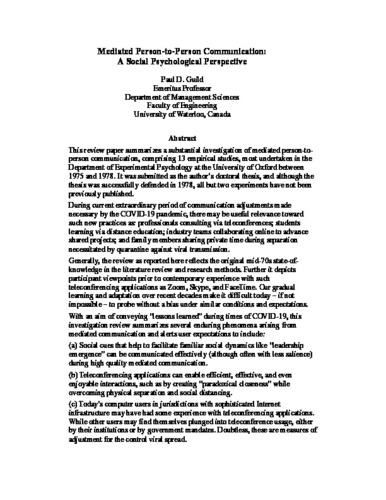| dc.contributor.author | Guild, Paul D. | |
| dc.date.accessioned | 2023-10-26 17:27:43 (GMT) | |
| dc.date.available | 2023-10-26 17:27:43 (GMT) | |
| dc.date.issued | 2023-10 | |
| dc.identifier.uri | http://hdl.handle.net/10012/20066 | |
| dc.description.abstract | This review paper summarizes a substantial investigation of mediated person-toperson
communication, comprising 13 empirical studies, most undertaken in the
Department of Experimental Psychology at the University of Oxford between
1975 and 1978. It was submitted as the author’s doctoral thesis, and although the
thesis was successfully defended in 1978, all but two experiments have not been
previously published.
During current extraordinary period of communication adjustments made
necessary by the COVID-19 pandemic, there may be useful relevance toward
such new practices as: professionals consulting via teleconferences; students
learning via distance education; industry teams collaborating online to advance
shared projects; and family members sharing private time during separation
necessitated by quarantine against viral transmission.
Generally, the review as reported here reflects the original mid-70s state-ofknowledge
in the literature review and research methods. Further it depicts
participant viewpoints prior to contemporary experience with such
teleconferencing applications as Zoom, Skype, and FaceTime. Our gradual
learning and adaptation over recent decades make it difficult today – if not
impossible – to probe without a bias under similar conditions and expectations.
With an aim of conveying “lessons learned” during times of COVID-19, this
investigation review summarizes several enduring phenomena arising from
mediated communication and alerts user expectations to include:
(a) Social cues that help to facilitate familiar social dynamics like “leadership
emergence” can be communicated effectively (although often with less salience)
during high quality mediated communication.
(b) Teleconferencing applications can enable efficient, effective, and even
enjoyable interactions, such as by creating “paradoxical closeness” while
overcoming physical separation and social distancing.
(c) Today’s computer users in jurisdictions with sophisticated Internet
infrastructure may have had some experience with teleconferencing applications.
While other users may find themselves plunged into teleconference usage, either
by their institutions or by government mandates. Doubtless, these are measures of
adjustment for the control viral spread. | en |
| dc.description.sponsorship | Doctoral Fellowship: The Canada Council and Department of Communication of the Government of Canada. | en |
| dc.language.iso | en | en |
| dc.publisher | University of Waterloo | en |
| dc.subject | mediated communication | en |
| dc.subject | social psychology | en |
| dc.subject | management of technology | en |
| dc.title | Mediated Person-to-Person Communication: A Social Psychological Perspective | en |
| dc.type | Preprint | en |
| dcterms.bibliographicCitation | Guild, Paul D. (2023). Mediated Person-to-Person Communication: A Social Psychological Perspective. University of Waterloo. | en |
| uws.contributor.affiliation1 | Faculty of Engineering | en |
| uws.contributor.affiliation2 | Management Sciences | en |
| uws.typeOfResource | Text | en |
| uws.peerReviewStatus | Unreviewed | en |
| uws.scholarLevel | Faculty | en |

